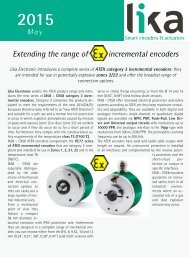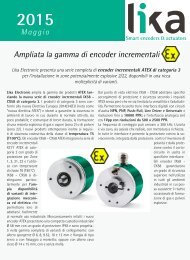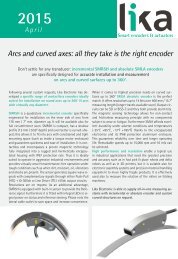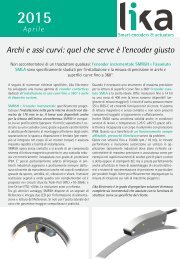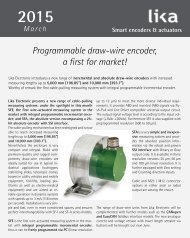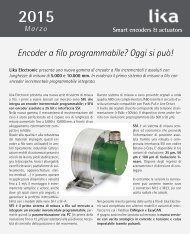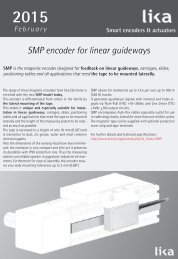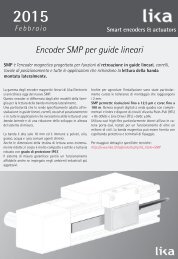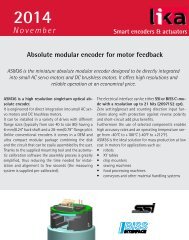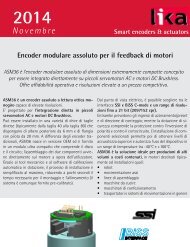LINEPULS & LINECOD catalogue 2016 in English
Lika Electronic incremental and absolute linear encoders catalogue 2016 in English Our new linear encoders catalogue is out now, and features many innovative new products and up-to-date information. The catalogue is expressly designed to set out the comprehensive range of incremental & absolute linear encoders from Lika Electronic. Check it out, it is completely renewed! Make sure you don’t miss out on a copy, download the pdf file from our web site or request your hard copy now! We have also got an interactive digital version in the works that shall be released soon!
Lika Electronic incremental and absolute linear encoders catalogue 2016 in English
Our new linear encoders catalogue is out now, and features many innovative new products and up-to-date information. The catalogue is expressly designed to set out the comprehensive range of incremental & absolute linear encoders from Lika Electronic. Check it out, it is completely renewed!
Make sure you don’t miss out on a copy, download the pdf file from our web site or request your hard copy now!
We have also got an interactive digital version in the works that shall be released soon!
You also want an ePaper? Increase the reach of your titles
YUMPU automatically turns print PDFs into web optimized ePapers that Google loves.
<strong>LINEPULS</strong><br />
Incremental l<strong>in</strong>ear encoders<br />
Incremental l<strong>in</strong>ear encoders<br />
An <strong>in</strong>cremental l<strong>in</strong>ear encoder uses a readhead fitted with MR magneto-resistive sensors<br />
and a magnetic tape to produce square waves signals or s<strong>in</strong>usoidal signals to output.<br />
As the North-South poles positional <strong>in</strong>formation encoded on the tape is cyclical, that is<br />
relative and ambiguous, this means that you can gather whether the axis is mov<strong>in</strong>g and the<br />
direction of the movement when the magnetic sensor passes along the tape; yet you cannot<br />
have <strong>in</strong>formation about its absolute position; for such reason you need a calibration po<strong>in</strong>t<br />
for measur<strong>in</strong>g reference.<br />
Incremental encoders seldom provide only one A output channel (uni-directional pulses).<br />
They can be used uniquely when the <strong>in</strong>formation on the direction of motion is not required.<br />
All Lika encoders are dual channel encoders at least.<br />
A channel (uni-directional output)<br />
The whole range of Lika <strong>in</strong>cremental<br />
encoders provides A and B output<br />
channels at least (bi-directional pulses,<br />
also referred to as quadrature).<br />
A and B channels supply square waves<br />
or cos<strong>in</strong>e-s<strong>in</strong>e signals phase-shifted<br />
by 90 electrical degrees. Thanks to<br />
this signal displacement, we can determ<strong>in</strong>e<br />
the direction of the motion.<br />
In fact when the ris<strong>in</strong>g edge of the<br />
signal A leads the ris<strong>in</strong>g edge of the<br />
signal B, the sensor is mov<strong>in</strong>g <strong>in</strong> the<br />
standard count<strong>in</strong>g direction; and<br />
on the contrary, when the ris<strong>in</strong>g edge<br />
of the signal B leads the ris<strong>in</strong>g edge<br />
of the signal A, the sensor is mov<strong>in</strong>g<br />
<strong>in</strong> the reverse count<strong>in</strong>g direction. This<br />
is right provided that the sensor is<br />
mounted properly and accord<strong>in</strong>g to<br />
the <strong>in</strong>stallation literature. For further<br />
<strong>in</strong>formation on mount<strong>in</strong>g and orient<strong>in</strong>g<br />
the tape and the sensor please<br />
refer to the section ”Mechanical and<br />
environmental <strong>in</strong>formation” on page<br />
16 and to the section “Orientation”<br />
on page 17.<br />
In the Figure the digital signals with<br />
<strong>in</strong>verted signals are represented after<br />
an <strong>in</strong>terpolation factor 4x.<br />
A and B channels (bi-directional<br />
output, s<strong>in</strong>gle ended output)<br />
When noisy electrical environment conditions or long cable lengths could lead to unsafe<br />
communication, A and B as well as Index and Reference signals should be paired with <strong>in</strong>verted<br />
signals (/AB0, typically referred to as A NOT, B NOT and 0 NOT).<br />
They are typically generated by <strong>in</strong>vert<strong>in</strong>g the electrical output (for <strong>in</strong>stance, when A signal<br />
goes HIGH, /A signal goes LOW and vice versa).<br />
Inverted signals allow pulses to be filtered <strong>in</strong> order to have clean signals.<br />
Noisy pulses (missed or extra pulses) affect both normal and complementary signals <strong>in</strong> the<br />
same way and thus they can be easily detected and trimmed.<br />
Inverted signals (complementary<br />
or differential outputs)<br />
See the Figure: the extra pulse (<strong>in</strong> red)<br />
which affects both channels A and /A<br />
can be easily trimmed by the differential<br />
receiver to obta<strong>in</strong> a clean signal.<br />
Inverted signals are always available<br />
with RS-422 and s<strong>in</strong>e wave output<br />
circuits and optionally with Push-Pull<br />
circuits (YC order code only).<br />
24




